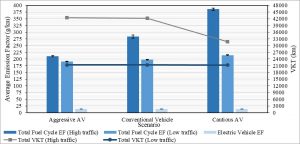Christos Stogios, MASc thesis, Civil Engineering, 2018
Professor Marianne Hatzopoulou and Professor Matthew J. Roorda, Co-supervisors
Summary
As technology advances and automation becomes more prominent in the operation of vehicles, the fabric of our urban environment and transportation networks will change significantly. Automated vehicles (AV) will inevitably have an impact on how people and goods are moved from one place to another. Identifying and quantifying the effects that automated vehicles will have on land use, traffic congestion and the environment have become of great interest to researchers in the field of transportation.
This study explores the effects of AVs and vehicle electrification on Greenhouse Gas (GHG) emissions and overall traffic congestion on both a freeway (Gardiner Expressway) and an urban street (College Street).
It is important to identify and quantify the inevitable changes that will result from the introduction of this new automated technology to better prepare for its arrival.
AVs have the potential to introduce positive changes to our urban environments, especially in terms of emission reductions. However, their driving style and the type of road (freeway vs. urban street) also play a role on the impacts that AVs have.

- As can be seen in Figure 1, when AVs are programmed to operate more aggressively (i.e., drive closer together) on a freeway, such as the Gardiner Expressway, the subsequent fuel cycle GHG emission factors are estimated to be reduced by 26%. However, more cautiously programmed AVs could deteriorate the traffic conditions and result in almost a 35% increase in GHG emissions.
- The effects of automated vehicles on urban streets, such as College Street, are determined to be minimal due to the stop-and-go nature of city driving with signalized intersections interrupting the potential efficiencies AV operations can introduce.
- When considering electrification of the vehicles, the tailpipe GHG emissions are essentially eliminated and the only emissions are from generating the required energy to power the vehicles. The carbon footprint of these electric vehicles is estimated to be reduced by 95%.
Co-supervisors contact information
Professor Marianne Hatzopoulou
Tel.: 416-978-0864
marianne.hatzopoulou@utoronto.ca
Professor Matthew J. Roorda
Tel: 416-978-5976
matt.roorda@utoronto.ca
